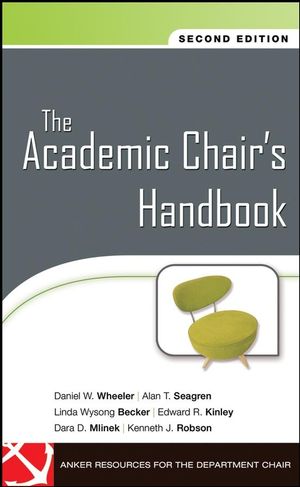The Academic Chair's Handbook, 2nd EditionISBN: 978-0-470-19765-3
Hardcover
304 pages
April 2008, Jossey-Bass
 This is a Print-on-Demand title. It will be printed specifically to fill your order. Please allow an additional 15-20 days delivery time. The book is not returnable.
|
||||||
About the Authors xi
Foreword xiii
Preface xvii
Part I • Fifteen Strategies in the Building Process
1. Difficulties in the Building Process 3
The Context for Leadership 4
Chairing the Department 7
The Nature of the Department 8
The Nature of Faculty Work 9
A Self-Assessment 10
Endnotes 13
Suggested Resources 13
2. Consider Your Own Development 15
Learn About Your Role and Responsibilities in the Department and the Institution 18
Create a Balance Between Your Professional and Personal Lives 24
Prepare for Your Professional Future 28
Conclusion 32
Endnotes 32
Suggested Resources 33
3. Reflect on Your Role as an Academic Leader 37
Establish a Collective Departmental Vision or Focus 38
Develop Faculty Ownership of the Vision 40
Initiate Changes Carefully 44
Allocate Resources of Time, Information, and Assignments to Implement the Vision and Departmental Goals 47
Monitor Progress Toward Achieving the Vision and Goals 50
Conclusion 51
Endnotes 52
Suggested Resources 52
4. Create a Positive Interpersonal Work Environment 55
Establish an Open Atmosphere to Build Trust 57
Listen to Faculty Needs and Interests 58
Motivate Faculty and Collaboratively Set Goals 60
Develop Leadership Skills that Empower Faculty and Provide Effective Feedback 62
Feedback Techniques 66
Represent Faculty to Colleagues and Senior Administrators 68
Serve as a Role Model and Mentor 69
Encourage and Support Faculty 70
Conclusion 72
Endnotes 72
Suggested Resources 73
Part II • Applying the Strategies
5. Help New Faculty Become Oriented 77
Communicate Expectations for Performance 80
Provide Feedback on Progress 83
Enhance Collegial Review Processes 84
Create Flexible Time Lines for Tenure 85
Encourage Mentoring and Integration by Senior Faculty 85
Extend Mentoring and Feedback to Graduate Students Who Aspire to be Faculty Members 87
Recognize the Department Chair as a Career Sponsor 88
Support Teaching, Particularly at the Undergraduate Level 90
Support Scholarly Development 91
Foster a Balance Between Professional and Personal Life 92
Conclusion 93
Endnotes 94
Suggested Resources 94
6. Improve Faculty Teaching 97
Promote Excellence in Teaching 98
Support Teaching Improvement 103
Address Teaching Problems 106
Employ Case Studies to Guide Your Response to
Teaching Problems 114
Conclusion 116
Suggested Resources 117
7. Improve the Scholarship of Faculty 119
Foster a Strong Research Climate 120
Detect a Problem Situation as Early as Possible 124
Clarify the Reasons for Lack of Performance 126
Identify a Plan for Improvement 128
Follow Up on the Plan 134
Conclusion 135
Endnotes 136
Suggested Resources 136
8. Refocus Faculty Efforts 139
Detect the Signs of Lack of Focus 141
Explore Options with the Individual 144
Mutually Design a Plan for Intervention 147
Arrange for Activities, Resources, and Feedback 149
Conclusion 150
Suggested Resources 152
9. Address Personal Issues of Faculty 155
Differentiate Between Short- and Long-Term Issues 156
Adopt Strategies for Temporary Problems 157
Adopt Strategies for Intervening in Chronic Cases 159
Conclusion 166
Suggested Resources 167
10. Employ Technology Wisely 169
Be Aware of Technological Developments 170
Encourage Faculty and Staff Technology Literacy 173
Support Technology Training 175
Use Technology Efficiently 176
Use Technology to Facilitate Outcomes, Assessment, and Accountability 179
Develop a Plan for Resource Allocation 181
Adopt Emerging Technologies Prudently 183
Consider the Impact on Student Services 185
Conclusion 185
Endnotes 186
Suggested Resources 187
11. Adapt to Funding and Resources Challenges 189
Clarify Responsibility for Budget Development and Allocation 190
Recognize the Implications of Budget Pressures 194
Diversify Funding Through Revenue Generation Strategies 197
Capitalize on Changes in Staffing 202
Maintain High Morale During Trying Times 203
Conclusion 206
Endnotes 206
Suggested Resources 207
12. Foster a Culture of Continuous Improvement 209
Make Continuous Improvement a Priority 211
Devise Strategies and Resources to Support Quality Improvement Efforts 213
Student Learning Assessment 214
Teaching Effectiveness Assessment 216
Program Effectiveness Assessment 217
Encourage Support of Continuous Improvement Efforts 218
Adopt Reliable Assessment Measures to Track Progress Over Time, Make Comparisons, and Demonstrate Results 220
An Illustration of the Process 222
Conclusion 223
Suggested Resources 225
13. Build an Agenda 227
Four Dimensions of the Building Process 228
Implementing the Agenda 238
Conclusion 239
Endnotes 242
References 243
Appendix A: The National Study and the Follow-Up Study 255
Appendix B: Topical Index to Strategies 259
Index 267



